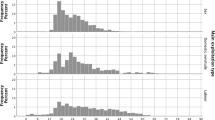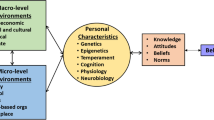Abstract
Many people who inject illicit drugs receive manual assistance when injecting, and this practice has been linked to increased risk of HIV infection and other harms. Little is known, however, about this practice among youth. This study uses a multivariate generalized estimating equation to identify factors associated with receiving assistance with injecting among a cohort of street-involved youth aged 14–26 in Vancouver, Canada. A total of 253 participants reported injecting drugs during the study period, and 49 % (n = 125) of these youth reported receiving assistance with injecting in the past 6 months. In multivariate analysis, younger age, female gender, binge drug use, heroin injecting, cocaine injecting, crystal methamphetamine injecting, and syringe sharing were positively and independently associated with assisted injection (all p < 0.05). These findings underscore the need for expanding substance abuse treatment alongside HIV prevention and health promotion interventions to empower youth to enact safer injection practices.
Similar content being viewed by others
References
Fairbairn N, Small W, Van Borek N, Wood E, Kerr T. Social structural factors that shape assisted injecting practices among injection drug users in Vancouver, Canada: a qualitative study. Harm Reduct J. 2010;7:20.
O’Connell JM, Kerr T, Li K, Tyndall MW, Hogg RS, Montaner JS, et al. Requiring help injecting independently predicts incident HIV infection among injection drug users. J Acquir Immune Defic Syndr. 2005;40(1):83–8.
Miller CL, Johnston C, Spittal PM, Li K, Laliberte N, Montaner JS, et al. Opportunities for prevention: hepatitis C prevalence and incidence in a cohort of young injection drug users. Hepatology. 2002;36(3):737–42.
Fairbairn N, Wood E, Small W, Stoltz JA, Li K, Kerr T. Risk profile of individuals who provide assistance with illicit drug injections. Drug Alcohol Depend. 2006;82(1):41–6.
Wood E, Spittal PM, Kerr T, Small W, Tyndall MW, O’Shaughnessy MV, et al. Requiring help injecting as a risk factor for HIV infection in the Vancouver epidemic: implications for HIV prevention. Can J Public Health Rev/Can de Sante Publique. 2003;94((5):355–9.
McNeil R, Small W, Lampkin H, Shannon K, Kerr T. “People knew they could come here to get help”: an ethnographic study of assisted injection practices at a peer-run ‘unsanctioned’ supervised drug consumption room in a Canadian setting. AIDS Behav. 2014;18(3):473–85.
Rhodes T. The ‘risk environment’: a framework for understanding and reducing drug-related harm. Int J Drug Policy. 2002;13(2):85–94.
Evans JL, Hahn JA, Page-Shafer K, Lum PJ, Stein ES, Davidson PJ, et al. Gender differences in sexual and injection risk behavior among active young injection drug users in San Francisco (the UFO Study). J Urban Health. 2003;80(1):137–46.
Bourgois P, Prince B, Moss A. The everyday violence of hepatitis C among young women who inject drugs in San Francisco. Hum Organ. 2004;63(3):253–64.
Small W, Shoveller J, Moore D, Tyndall M, Wood E, Kerr T. Injection drug users’ access to a supervised injection facility in Vancouver, Canada: the influence of operating policies and local drug culture. Qual Health Res. 2011;21(6):743–56.
Kerr T, Wood E, Small D, Palepu A, Tyndall MW. Potential use of safer injecting facilities among injection drug users in Vancouver’s Downtown Eastside. Can Med Assoc J. 2003;169(8):759–63.
Damon W, Neufeld S. Underground safe-injection site forced to close: Vancouver health authority shuts down unsanctioned drug user-run site in the Downtown Eastside. Megaphone; 2014.http://www.megaphonemagazine.com/underground_safe_injection_site_forced_to_close. Accessed 1 June 2015.
Lloyd-Smith E, Rachlis BS, Tobin D, Stone D, Li K, Small W, et al. Assisted injection in outdoor venues: an observational study of risks and implications for service delivery and harm reduction programming. Harm Reduct J. 2010;7:6.
Marshall BD, Kerr T, Qi J, Montaner JS, Wood E. Public injecting and HIV risk behaviour among street-involved youth. Drug Alcohol Depend. 2010;110(3):254–8.
Marshall B, Kerr T, Shoveller J, Montaner J, Wood E. Structural factors associated with an increased risk of HIV and sexually transmitted infection transmission among street-involved youth. BMC Public Health. 2009;9(1):7.
DeMatteo D, Major C, Block B, Coates R, Fearon M, Goldberg E, et al. Toronto street youth and HIV/AIDS: prevalence, demographics, and risks. J Adolesc Health. 1999;25(5):358–66.
Marshall BDL, Kerr T, Shoveller JA, Patterson TL, Buxton JA, Wood E. Homelessness and unstable housing associated with an increased risk of HIV and STI transmission among street-involved youth. Health Place. 2009;15(3):783–90.
Wood E, Stoltz JA, Montaner JS, Kerr T. Evaluating methamphetamine use and risks of injection initiation among street youth: the ARYS study. Harm Reduct J. 2006;3:18.
Marshall BD. The contextual determinants of sexually transmissible infections among street-involved youth in North America. Cult health Sex. 2008;10(8):787–99.
Roy E, Haley N, Leclerc P, Sochanski B, Boudreau JF, Boivin JF. Mortality in a cohort of street youth in Montreal. JAMA. 2004;292(5):569–74.
Roy É, Robert M, Fournier L, Vaillancourt É, Vandermeerschen J, Boivin J-F. Residential trajectories of street youth—the Montréal cohort study. J Urban Health. 2014;91(5):1019–31.
Uhlmann S, DeBeck K, Simo A, Kerr T, Montaner JS, Wood E. Health and social harms associated with crystal methamphetamine use among street-involved youth in a Canadian setting. Am J Addict/Am Acad Psychiatr Alcohol Addict. 2014;23(4):393–8.
Hadland SE, Marshall BD, Kerr T, Zhang R, Montaner JS, Wood E. A comparison of drug use and risk behavior profiles among younger and older street youth. Subst Use Misuse. 2011;46(12):1486–94.
Ballinger GA. Using generalized estimating equations for longitudinal data analysis. Organ Res Methods. 2004;7(2):127–50.
Hanley JA, Negassa A, Edwardes MD, Forrester JE. Statistical analysis of correlated data using generalized estimating equations: an orientation. Am J Epidemiol. 2003;157(4):364–75.
Pan W. Akaike’s information criterion in generalized estimating equations. Biometrics. 2001;57(1):120–5.
Kral AH, Bluthenthal RN, Erringer EA, Lorvick J, Edlin BR. Risk factors among IDUs who give injections to or receive injections from other drug users. Addiction. 1999;94(5):675–83 (Abingdon, England).
Fairbairn N, Small W, Shannon K, Wood E, Kerr T. Seeking refuge from violence in street-based drug scenes: women’s experiences in North America’s first supervised injection facility. Soc Sci Med. 2008;67(5):817–23.
Fast D, Small W, Wood E, Kerr T. Coming ‘down here’: young people’s reflections on becoming entrenched in a local drug scene. Soc Sci Med. 2009;69(8):1204–10.
Werb D, Kerr T, Buxton J, Shoveller J, Richardson C, Montaner J, et al. Crystal methamphetamine and initiation of injection drug use among street-involved youth in a Canadian setting. Can Med Assoc J. 2013;185(18):1569–75.
Small W, Fast D, Krusi A, Wood E, Kerr T. Social influences upon injection initiation among street-involved youth in Vancouver, Canada: a qualitative study. Subst Abuse Treat Prev Policy. 2009;4:8.
Kerr T, Oleson M, Tyndall MW, Montaner J, Wood E. A description of a peer-run supervised injection site for injection drug users. J Urban Health. 2005;82(2):267–75.
Small W, Wood E, Tobin D, Rikley J, Lapushinsky D, Kerr T. The injection support team: a peer-driven program to address unsafe injecting in a Canadian setting. Subst Use Misuse. 2012;47(5):491–501.
Hayashi K, Wood E, Wiebe L, Qi J, Kerr T. An external evaluation of a peer-run outreach-based syringe exchange in Vancouver Canada. Int J Drug Policy. 2010;21(5):418–21.
Ritter A, Ritter A, Cameron J, Ritter A, Cameron J. A review of the efficacy and effectiveness of harm reduction strategies for alcohol, tobacco and illicit drugs. Drug Alcohol Rev. 2006;25(6):611–24.
Buxton JA, Dove NA. The burden and management of crystal meth use. Can Med Assoc J. 2008;178(12):1537–9.
Miller CL, Kerr T, Frankish JC, Spittal PM, Li K, Schechter MT, et al. Binge drug use independently predicts HIV seroconversion among injection drug users: implications for public health strategies. Subst Use Misuse. 2006;41(2):199–210.
Miller CL, Strathdee SA, Kerr T, Li K, Wood E. Factors associated with early adolescent initiation into injection drug use: implications for intervention programs. J Adolesc Health. 2006;38(4):462–4.
Ochnio JJ, Patrick D, Ho M, Talling DN, Dobson SR. Past infection with hepatitis A virus among Vancouver street youth, injection drug users and men who have sex with men: implications for vaccination programs. Can Med Assoc J. 2001;165(3):293–7.
Podsakoff PM, MacKenzie SB, Lee J-Y, Podsakoff NP. Common method biases in behavioral research: a critical review of the literature and recommended remedies. J Appl Psychol. 2003;88(5):879.
Brener ND, Collins JL, Kann L, Warren CW, Williams BI. Reliability of the youth risk behavior survey questionnaire. Am J Epidemiol. 1995;141(6):575–80.
Darke S. Self-report among injecting drug users: a review. Drug Alcohol Depend. 1998;51(3):253–63.
Rosenbaum JE. Truth or consequences: the intertemporal consistency of adolescent self-report on the youth risk behavior survey. Am J Epidemiol. 2009;169(11):1388–97.
Small W, Krusi A, Wood E, Montaner J, Kerr T. Street-level policing in the Downtown Eastside of Vancouver, Canada, during the 2010 Winter Olympics. Int J Drug Policy. 2012;23(2):128–33.
Samet JH, Friedmann P, Saitz R. Benefits of linking primary medical care and substance abuse services: patient, provider, and societal perspectives. Arch Intern Med. 2001;161(1):85–91.
Acknowledgments
The authors thank the study participants for their contribution to the research, as well as current and past researchers and staff. We would specifically like to thank Cody Callon, Deborah Graham, Peter Vann, Steve Kain, Kristie Starr, Tricia Collingham, and Carmen Rock for their research and administrative assistance. This research was undertaken, in part, thanks to funding from the Canada Research Chairs program through a Tier 1 Canada Research Chair in Inner City Medicine which supports Dr. Evan Wood. Dr. Kora DeBeck is supported by a MSFHR/St. Paul’s Hospital Foundation‐Providence Health Care Career Scholar Award and a CIHR New Investigator Award. Dr. Julio Montaner is supported by the British Columbia Ministry of Health and the US National Institutes of Health (NIDA-R01DA036307). He has also received limited unrestricted grants from Abbvie, Bristol-Myers Squibb, Gilead Sciences, Janssen, Merck, and ViiV Healthcare. Dr. Will Small is supported by a MSFHR Career Scholar Award. This study was supported by the US National Institutes of Health (R01DA028532; U01DA038886) and the Canadian Institutes of Health Research (MOP–102742).
Author information
Authors and Affiliations
Corresponding author
Rights and permissions
About this article
Cite this article
Cheng, T., Kerr, T., Small, W. et al. High Prevalence of Assisted Injection Among Street-Involved Youth in a Canadian Setting. AIDS Behav 20, 377–384 (2016). https://doi.org/10.1007/s10461-015-1101-3
Published:
Issue Date:
DOI: https://doi.org/10.1007/s10461-015-1101-3




